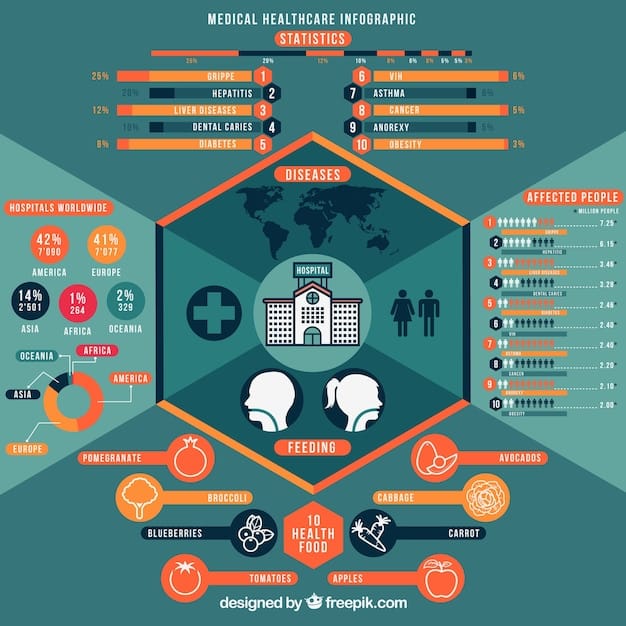White House Initiatives Combat Rising Healthcare Costs

The White House recently unveiled a series of comprehensive initiatives aimed at tackling the escalating cost of healthcare, focusing on prescription drug affordability, hospital pricing transparency, and expanding access to care for all Americans.
In a move addressing one of the most pressing concerns for American families, the White House recently announced significant new initiatives to combat rising healthcare costs, signaling a dedicated effort to alleviate financial burdens and improve health outcomes nationwide.
Dissecting the Prescription Drug Price Reduction Strategy
The core of the White House’s latest push against high healthcare costs involves a multi-pronged attack on prescription drug pricing, an issue that has plagued American consumers for decades. This strategy integrates various mechanisms designed to increase competition, promote transparency, and empower federal agencies in negotiating lower prices on behalf of patients.
One of the cornerstone policies is expanding the Medicare Drug Price Negotiation Program. Initially established under the Inflation Reduction Act, this program allows Medicare to directly negotiate the prices of certain high-cost prescription drugs. The current administration seeks to accelerate the pace and broaden the scope of this negotiation, bringing more drugs under the program sooner than initially planned. This expansion is poised to generate significant savings for seniors and disabled individuals, directly impacting out-of-pocket costs.
Enhanced Negotiation Powers and Scope
The ambition goes beyond merely accelerating existing negotiations. There’s a strong push to grant federal agencies broader authority in these discussions, moving towards a model where the government can exert more leverage against pharmaceutical companies. This includes potentially negotiating for a wider array of drugs, even those newly introduced to the market, if they meet certain criteria for high cost and essentiality. The administration argues that this proactive stance is necessary to prevent future price gouging and ensure equitable access to life-saving medications.
Transparency also plays a crucial role in this strategy. New regulations are being drafted to require pharmaceutical companies to disclose more detailed information about their drug development costs, marketing expenses, and pricing structures. The rationale behind this is simple: by shedding light on the opaque world of drug pricing, consumers and policymakers alike will be better equipped to understand the true drivers of high costs and identify areas for intervention.
- Increased federal negotiation power.
- Broader scope of drugs eligible for negotiation.
- Mandatory disclosure of drug manufacturing and marketing costs.
Furthermore, the White House is exploring initiatives to foster greater competition within the pharmaceutical market. This includes measures to speed up the approval process for generic and biosimilar drugs, which often serve as more affordable alternatives to their brand-name counterparts. By reducing barriers to entry for these competitors, the administration hopes to naturally drive down prices through market forces. The long-term goal is to create an environment where innovation is rewarded, but not at the expense of patient affordability.
Ultimately, the White House’s strategy to reduce prescription drug prices represents a comprehensive and aggressive approach. It combines direct negotiation with market-based solutions and increased transparency, aiming to shift the balance of power towards consumers and away from the unchecked pricing practices of some pharmaceutical giants. This multi-faceted strategy underscores a commitment to making essential medications accessible and affordable for all Americans.
Addressing Hospital Pricing Transparency and Surprise Billing
Beyond prescription drugs, the White House is rigorously focusing on the opaque world of hospital pricing and the pervasive issue of surprise medical billing. These areas have long been sources of financial distress for patients, often leading to unforeseen and exorbitant costs for services received at in-network facilities but from out-of-network providers. The new initiatives aim to bring unprecedented clarity and accountability to these complex systems.
A key pillar of this effort is the robust enforcement of existing hospital price transparency rules, coupled with expanded requirements. Currently, hospitals are mandated to publish their standard charges for all services, both negotiated rates with insurers and discounted cash prices. However, compliance has been inconsistent. The administration plans to increase auditing and implement stricter penalties for non-compliant hospitals, ensuring that patients and third-party tools can readily access accurate pricing information before services are rendered.
Cracking Down on Surprise Medical Bills
The “No Surprises Act,” enacted in 2022, was a significant step forward in protecting patients from unexpected out-of-network charges in emergency situations or from ancillary providers (like anesthesiologists or radiologists) at in-network facilities. The White House is now working to strengthen the implementation and awareness of this Act. This involves clearer communication to patients about their rights under the law and ensuring that the independent dispute resolution process, which mediates payment disputes between providers and insurers, functions efficiently and fairly.
New proposals are also on the table to extend protections beyond what the “No Surprises Act” currently covers. This could include situations where patients unknowingly receive care from out-of-network providers in non-emergency settings, or where facilities attempt to circumvent the rules through aggressive billing practices. The goal is to close loopholes and create a comprehensive safety net against surprise bills, providing patients with peace of mind and financial predictability.
- Increased enforcement of hospital price transparency.
- Stronger penalties for non-compliant hospitals.
- Expanded patient protections against surprise medical bills.
Furthermore, the administration is examining hospital mergers and acquisitions with a more critical eye. Consolidation in the healthcare market, particularly among hospitals, has been linked to higher prices and reduced competition. The White House, through the Department of Justice and the Federal Trade Commission, is committed to scrutinizing these mergers to ensure they do not harm consumers by stifling competition and inflating costs. This proactive regulatory stance seeks to maintain a more balanced and competitive healthcare landscape.
These initiatives collectively aim to empower consumers with knowledge and protection. By making pricing transparent and eradicating surprise bills, the White House is striving to transform healthcare from a labyrinth of hidden charges into a more predictable and consumer-friendly service, fostering trust and alleviating financial strain on American families.

Expanding Access and Affordability Through Public Programs
A crucial component of the White House’s strategy to combat rising healthcare costs extends to broadening access and enhancing the affordability of health coverage itself through public programs. The understanding is clear: reducing the cost of care is ineffective if people cannot access it in the first place. Therefore, initiatives focus on strengthening existing frameworks and introducing new pathways to coverage for underserved populations.
Central to this effort is the continued fortification of the Affordable Care Act (ACA) marketplace. The administration has heavily promoted enrollment in ACA plans, leveraging enhanced subsidies provided by the Inflation Reduction Act to make coverage more affordable than ever before for millions of Americans. These subsidies have significantly reduced monthly premiums, bringing previously out-of-reach plans within financial grasp for low and middle-income families.
Strengthening Medicaid and Medicare
Beyond the ACA, significant attention is being directed towards Medicaid and Medicare, the nation’s largest public health insurance programs. For Medicaid, the White House is encouraging the remaining non-expansion states to adopt the ACA’s Medicaid expansion, which would extend coverage to millions of low-income adults. This is seen as a vital step to close coverage gaps and ensure that economically vulnerable populations have access to essential healthcare services without incurring crippling debt.
For Medicare, in addition to drug price negotiations, the administration is exploring ways to expand covered benefits, potentially including dental, vision, and hearing coverage, which are often significant out-of-pocket expenses for seniors. While these expansions are complex and require legislative action, the White House is advocating strongly for their inclusion to reduce the financial burden on older Americans and improve their overall quality of life.
- Continued fortification and promotion of ACA marketplace subsidies.
- Advocacy for Medicaid expansion in all states.
- Exploration of expanded benefits within Medicare (dental, vision, hearing).
Furthermore, initiatives are underway to address disparities in healthcare access, particularly in rural and underserved urban areas. This includes investments in community health centers, which provide integrated primary care services regardless of a patient’s ability to pay. There’s also a focus on expanding the healthcare workforce in these areas, including recruiting more primary care physicians, nurses, and mental health professionals, often through loan forgiveness programs and scholarships.
The administration also recognizes the importance of mental health parity. Efforts are being made to ensure that mental health and substance abuse disorder services are covered at the same level as physical health services by insurance plans. This means tackling discriminatory practices by insurers and increasing awareness among beneficiaries of their rights to comprehensive mental healthcare without disproportionate costs. By expanding both physical and mental health access, the White House aims to create a more equitable and inclusive healthcare system for all.
Innovation in Care Delivery and Preventive Health
A forward-thinking aspect of the White House’s healthcare cost initiatives involves fostering innovation in care delivery and placing a greater emphasis on preventive health. The traditional fee-for-service model often incentivizes volume over value, contributing to spiraling costs. Therefore, efforts are being made to shift towards models that reward quality outcomes, patient satisfaction, and proactive health management.
One primary focus is on promoting value-based care models. Rather than paying providers for each individual service rendered, these models incentivize comprehensive care that keeps patients healthy and out of the hospital. This includes accountable care organizations (ACOs), where groups of doctors, hospitals, and other healthcare providers work together to provide coordinated high-quality care to their Medicare patients. If they meet quality metrics and reduce costs, they share in the savings.
Leveraging Technology and Telehealth
Technology also plays a pivotal role in this innovative approach. The rapid expansion of telehealth services during the pandemic demonstrated its potential for improving access to care, particularly for those in remote areas or with mobility challenges, while also potentially reducing costs associated with in-person visits. The White House is pushing for permanent telehealth flexibilities and reimbursement parity to ensure these services remain a viable and affordable option for patients.
Furthermore, there are initiatives to enhance the interoperability of electronic health records (EHRs). Seamless sharing of patient data among different providers can prevent redundant tests, improve care coordination, and reduce medical errors, all of which contribute to lower costs and better patient outcomes. The administration is working with healthcare systems and technology developers to accelerate the adoption of unified, patient-centric EHR systems.
- Promotion of value-based care models (e.g., ACOs).
- Support for permanent telehealth expansion and reimbursement.
- Emphasis on interoperability of electronic health records.
Preventive health is another cornerstone. Investing in population health initiatives, such as vaccination campaigns, chronic disease management programs, and public health education, can prevent serious illnesses and costly hospitalizations down the line. The White House is advocating for increased funding and stronger policy support for these programs, recognizing that a healthier population is inherently a more cost-efficient population.
Finally, there’s a push for greater integration of behavioral health services within primary care settings. Addressing mental and physical health in a holistic manner can lead to better overall health outcomes and reduce the need for more intensive and expensive specialized care later. By embracing these innovations in care delivery and prioritizing prevention, the White House aims to build a more sustainable, effective, and affordable healthcare system for the long term.
Protecting Consumers and Fostering Competition: A Broader Economic Lens
The White House’s strategy to combat rising healthcare costs isn’t solely confined to direct healthcare policies; it also encompasses a broader economic approach centered on consumer protection and fostering robust market competition. The administration recognizes that unchecked monopolistic practices and inadequate oversight in various sectors contribute to inflated prices across the economy, including healthcare.
A key aspect of this is enhanced antitrust enforcement. The Department of Justice and the Federal Trade Commission (FTC) have been directed to scrutinize mergers and acquisitions within the healthcare sector with renewed vigor. This includes not only hospital mergers, as previously mentioned, but also those involving pharmaceutical companies, pharmacy benefit managers (PBMs), and other segments of the healthcare industry. The goal is to prevent consolidations that reduce competition, limit patient choice, and ultimately lead to higher prices.
Empowering Regulatory Agencies and Consumer Watchdogs
Beyond traditional antitrust, there’s an effort to empower regulatory agencies to address anticompetitive practices that may not rise to the level of an illegal merger but still harm consumers. This includes scrutinizing contractual agreements between providers and insurers that might limit competition or steer patients towards higher-cost options. The administration aims to equip these agencies with the data and authority needed to proactively identify and remedy such issues.
Consumer protection agencies are also playing a more direct role. The Consumer Financial Protection Bureau (CFPB), for instance, has been encouraged to look into medical debt issues, holding debt collectors accountable for predatory practices and ensuring fair treatment for patients struggling with bills. This multi-agency approach ensures that various levers of government are engaged in tackling the financial aspects of healthcare costs from different angles.
- Increased antitrust scrutiny of healthcare mergers across all sub-sectors.
- Empowering regulatory bodies to address anticompetitive market behaviors.
- Enhanced role for consumer protection agencies in medical debt and billing practices.
Moreover, the administration is advocating for better data collection and transparency across the entire healthcare ecosystem. Understanding where money flows and what profits are being generated at each step of the healthcare supply chain – from drug manufacturers to PBMs, wholesalers, and pharmacies – is crucial for identifying areas where costs are artificially inflated. This data-driven approach aims to arm policymakers with the insights needed to craft effective interventions.
Finally, there’s a strong emphasis on promoting innovation that truly benefits consumers, rather than just corporate bottom lines. This includes supporting research and development in areas that address unmet medical needs and encouraging the adoption of technologies that genuinely improve efficiency and patient outcomes. By looking at healthcare not just as a service, but as a critical part of the broader economy, the White House aims to create a more fair, competitive, and ultimately more affordable healthcare landscape for all Americans.
Challenges and the Path Ahead
While the White House’s new initiatives represent a significant and concerted effort to combat rising healthcare costs, the path forward is fraught with challenges. The healthcare industry is vast, complex, and deeply entrenched, involving powerful stakeholders with vested interests. Navigating this landscape requires not only determined policy but also sustained political will and broad societal consensus.
One of the primary challenges lies in overcoming political polarization and securing bipartisan support for enduring reforms. Healthcare policy has historically been a highly contentious arena, with proposals often becoming entangled in partisan battles. For these initiatives to have a lasting impact beyond a single administration, they need to be robust enough to withstand political shifts and gain wide legislative backing.
Industry Opposition and Legal Hurdles
Another significant hurdle is the inevitable opposition from powerful industry lobbies. Pharmaceutical companies, hospital systems, and insurance providers often deploy substantial resources to challenge policies that threaten their profit margins. This can manifest in intense lobbying efforts, public relations campaigns, and legal challenges designed to delay or derail implementation of new regulations. The administration must be prepared for protracted battles in both the legislative and judicial spheres.
The sheer administrative complexity of implementing such wide-ranging reforms also presents a formidable task. Overhauling pricing structures, enforcing new transparency rules, and expanding public programs require significant coordination across multiple federal agencies, states, and private entities. Ensuring consistent application and effective oversight will be an ongoing logistical challenge, demanding substantial resources and dedicated personnel.
- Overcoming political polarization and securing bipartisan support.
- Anticipating and mitigating strong opposition from entrenched industry lobbies.
- Managing the immense administrative complexity of implementing widespread reforms.
Furthermore, measuring the true impact of these initiatives will take time. Healthcare cost trends are influenced by a multitude of factors, including inflation, demographic shifts, and the pace of medical innovation. Differentiating the effects of specific policies from these broader environmental pressures will require rigorous data collection and analysis over several years. Immediate and dramatic reductions in costs may not be evident, requiring patience and a long-term perspective.
Ultimately, the success of these White House initiatives will depend on their ability to fundamentally alter the incentives within the healthcare system, shifting focus from volume to value, from opacity to transparency, and from corporate profits to patient affordability. It’s a daunting task, but one that could profoundly reshape the financial landscape of healthcare for millions of Americans, providing much-needed relief from escalating costs.
Community Impact and the Patient Perspective
While policy discussions often focus on grand strategies and economic models, the true measure of success for the White House’s healthcare cost initiatives lies in their practical impact on communities and individual patients. The rising burden of medical expenses has far-reaching consequences, affecting not only physical health but also financial stability, mental well-being, and overall quality of life for families across the nation. These new policies aim to translate abstract reforms into tangible benefits for everyday Americans.
From the patient’s perspective, the direct financial relief promised by lower prescription drug costs and protection from surprise bills could be transformative. For many, a single high-cost medication or an unexpected medical emergency can wipe out savings, lead to debt, or even bankruptcy. Reduced out-of-pocket expenses free up household budgets for other necessities, improving economic security and reducing stress, which itself can positively impact health outcomes.
Empowering Patients as Consumers
Increased transparency in hospital pricing, while not immediately intuitive for every patient, lays the groundwork for a more informed healthcare consumer. The ability to compare prices for procedures and services, even if through third-party tools, injects a much-needed element of market competition into what has historically been a black box. This empowerment allows patients to advocate for themselves and make more economically sensible choices, wherever possible.
Moreover, the expansion of access to affordable insurance through strengthened ACA subsidies and potential Medicaid expansion means fewer individuals are forced to forgo necessary medical care due to cost. Preventative screenings, early treatment for chronic conditions, and access to mental health services become more achievable, leading to healthier communities and reducing the strain on emergency rooms, which often serve as a costly last resort for the uninsured or underinsured.
- Lower out-of-pocket costs for prescription drugs.
- Protection from financially devastating surprise medical bills.
- Greater transparency allowing for informed healthcare choices.
The broader impact on communities stems from a healthier, more financially secure populace. When healthcare costs are manageable, individuals are more likely to participate in the workforce, pursue educational opportunities, and contribute actively to their local economies. Conversely, medical debt can entrap families in cycles of poverty, impacting entire neighborhoods and regions.
Ultimately, the White House initiatives seek to reaffirm a fundamental principle: access to affordable healthcare is not a luxury, but a basic right and a cornerstone of a thriving society. By bringing tangible financial relief and greater predictability to healthcare expenses, these policies aspire to foster a healthier, more resilient America, where the pursuit of well-being doesn’t come at the cost of financial ruin. The collective impact on patient peace of mind and community well-being will be a critical measure of their long-term success.
| Key Area | Brief Description |
|---|---|
| 💊 Drug Pricing | Expanded Medicare negotiation and transparency requirements. |
| 🏥 Hospital Costs | Stricter enforcement of price transparency and “No Surprises Act.” |
| 💲 Access & Affordability | Fortifying ACA subsidies and advocating for Medicaid expansion. |
| 💡 Innovation | Promoting value-based care, telehealth, and preventive health. |

Frequently Asked Questions About Healthcare Cost Initiatives
▼
The primary goals are to reduce the financial burden of healthcare on American families, particularly concerning prescription drug prices and hospital costs. They also aim to expand access to affordable health coverage and promote greater transparency and competition within the healthcare industry to ensure better value for consumers.
▼
The initiatives seek to lower prescription drug prices primarily by expanding Medicare’s ability to negotiate drug costs for a wider range of medications. They also aim to increase transparency regarding drug development and marketing costs, and to facilitate the market entry of more generic and biosimilar alternatives.
▼
The administration is strengthening enforcement of hospital price transparency rules, ensuring hospitals publish clear standard charges. Additionally, they are working to enhance and communicate the “No Surprises Act” protections more effectively, shielding patients from unexpected charges from out-of-network providers in in-network facilities.
▼
Access is being expanded through continued robust subsidies for health plans on the Affordable Care Act (ACA) marketplace, making coverage more affordable. The White House is also advocating for Medicaid expansion in all states and exploring potential enhancements to Medicare benefits, such as dental and vision coverage, to a broader population.
▼
Challenges include overcoming political opposition and securing bipartisan support for lasting reforms. The administration also anticipates significant resistance from powerful industry lobbies, as well as the immense administrative complexity of implementing such sweeping changes across the diverse and fragmented U.S. healthcare system effectively.
Conclusion
The White House’s recent announcement of new initiatives to combat rising healthcare costs marks a comprehensive and determined effort to address one of the most significant financial burdens facing American families. By focusing on prescription drug affordability, hospital pricing transparency, the elimination of surprise billing, and the expansion of access to affordable coverage, the administration is pursuing a multi-faceted approach. While the path to significant and lasting change remains challenging, these policies signal a clear commitment to fostering a more equitable, transparent, and ultimately more affordable healthcare system for all Americans, with the potential to profoundly impact the financial well-being and health outcomes of millions across the nation.





